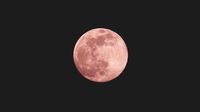The astronomical phenomenon known as the Pink Moon will grace the skies on April 12, 2025, offering a spectacular visual treat for stargazers around the world. This full moon, which reaches its maximum visibility at 18:22 hours, is particularly noteworthy as it coincides with Palm Sunday, marking an important date on the liturgical calendar.
The term "Pink Moon" does not imply that the moon will actually appear pink. Instead, it derives its name from the pink moss, or Phlox subulata, a wildflower that blooms in early spring. According to NASA, this name was popularized by the Farmer's Almanac in the 1930s, reflecting the natural cycles observed by Native Americans. Other names for this full moon include the Sprouting Grass Moon, the Egg Moon, and the Fish Moon, the latter being used by coastal tribes to signify the time when shad fish swim upstream to spawn.
The Pink Moon will be visible in various regions, including Central and South America, as well as the southern coasts of South Africa. In countries like Nicaragua, Costa Rica, and Panama, observers will have the unique opportunity to witness the star Spica reappearing behind the moon after being obscured. In Colombia, Ecuador, Venezuela, Chile, Bolivia, Paraguay, Argentina, and Brazil, stargazers will be able to enjoy both the disappearance and reappearance of Spica, the brightest star in the constellation Virgo, which will shine near the moon during this event.
As the moon reaches its full phase, it will appear larger and brighter than usual due to its proximity to Earth. This phenomenon, often referred to as a "microluna," occurs when the moon is at apogee, the point in its orbit where it is farthest from Earth. While the difference in size may be subtle, it can still enhance the viewing experience for those who seek out dark, unobstructed locations away from city lights.
Interestingly, the Pink Moon also holds significant astrological implications. Astrologers describe this full moon as a time of renewal and transformation, coinciding with the entry of Pluto into Aquarius for the first time. This alignment is said to bring about changes and evolution, urging individuals to stay true to their hearts amidst the rapid shifts that may occur.
Despite the widespread belief that full moons can influence human behavior, scientific studies have found no conclusive evidence to support these claims. A notable study published in the "Journal of Psychiatric Research" in 1998 concluded that the full moon does not have a significant impact on psychological conditions or human behavior. Nevertheless, the allure of the Pink Moon continues to inspire a sense of wonder and curiosity among many.
For those eager to catch a glimpse of this celestial event, it is advisable to find a location that is free from light pollution and visual obstructions, such as buildings or trees. As the moon begins to rise on the night of April 11, it will gradually reach its full brightness, peaking on April 12 before starting to wane.
In summary, the Pink Moon of April 2025 promises to be an enchanting spectacle, merging cultural significance with natural beauty. Whether one is an avid astronomer or a casual observer, this event presents an opportunity to connect with the rhythms of nature and the cosmos.









